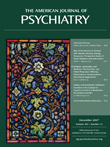The Black Box Warning: Decreased Prescriptions and Increased Youth Suicide?
To The Editor: The article by Robert D. Gibbons, Ph.D., et al., published in the September 2007 issue of the Journal , incorrectly analyzed the relationship between U.S. selective serotonin reuptake inhibitor (SSRI) prescription rates and suicide rates among children (1) . Dr. Gibbons et al. indicated that there is a correspondence between a 22% decrease in prescriptions after warnings were issued by the Food and Drug Administration (FDA) and the 14% increase in youth suicide rates between 2003 and 2004. They concluded that decreases in prescriptions “were associated with increases in suicide rates in children and adolescents” ( 1 , p. 1357). Unless carefully examined, Figure 1 and Figure 2 in their article create the same impression. However, the data show no such association. In the year in which suicide rates rose sharply, there was no significant drop in SSRI prescribing. This fact is only acknowledged in the Discussion section, where an attempt is made to explain away the inconvenient truth: “While only a small decrease in the SSRI prescription rate for U.S. children and adolescents occurred from 2003 to 2004, the public health warnings may have left some of the most vulnerable youths untreated” ( 1 , p. 1359). The discussion then continues at length as though a clear association (if not causal relationship) has been established, with alarmist predictions regarding the consequences of decreased prescribing. As it turns out, preliminary figures are now available from the Centers for Disease Control (CDC), which show that fewer people under age 25 committed suicide in 2005 (when prescribing did decrease) than in 2004 (2) .
In the editorial accompanying the article, James F. Leckman, M.D., and Robert A. King, M.D., noted that the authors cited several studies that agreed with their position, but no studies that reported neutral or opposite findings (3) . There is no mention of the fact that the suicide rate was already declining before SSRIs were introduced. The 2004 suicide figures were compared simplistically with the previous year, rather than examining the change in trends over several years. The y axes were contracted to make trends appear more impressive and no data tables were provided, and thus it is difficult for readers to make their own calculations.
1. Gibbons RD, Brown CH, Hur K, Marcus SM, Bhaumik DK, Erkens JA, Herings R, Mann JJ: Early evidence on the effects of regulators’ suicidality warnings on SSRI prescriptions and suicide in children and adolescents. Am J Psychiatry 2007; 164:1356–1363Google Scholar
2. Kung HC, Hoyert DL, Xu J, Murphy SL: Deaths: Preliminary Data for 2005. Hyattsville, Md, National Center for Health Statistics, 2005. http://www.cdc.gov/nchs/products/pubs/pubd/hestats/prelimdeaths05/prelimdeaths05.htm (accessed September 2007)Google Scholar
3. Leckman JF, King RA: A developmental perspective on the controversy surrounding the use of SSRIs to treat pediatric depression (editorial). Am J Psychiatry 2007; 164:1304–1306Google Scholar



